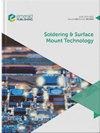微量Ni元素掺杂对Sn/Ni(多晶/单晶)接头界面行为的影响
IF 1.7
4区 材料科学
Q3 ENGINEERING, ELECTRICAL & ELECTRONIC
引用次数: 29
摘要
目的研究微量Ni的掺杂对Sn-xNi(x=0、0.05和0.1wt.%)/Ni(多晶/单晶,简称PC-Ni/SC-Ni)焊点在回流和时效过程中微观结构演变的影响。结果表明,Sn-xNi/PC-Ni接头界面层的金属间化合物(IMCs)为Ni3Sn4相,而Sn-xNi/SC-Ni接头的IMCs为NiSn4相。在回流工艺和不同接头的热老化后,由于两种衬底的元素扩散机制不同,界面层的生长行为也不同。PC-Ni衬底主要通过晶界扩散提供Ni原子。Sn0.05Ni/PC-Ni接头的Ni3Sn4相更细,Sn和Ni元素的扩散通量增加,因此该接头的Ni_3Sn4层最厚。SC-Ni衬底主要通过晶格扩散提供Ni原子。由于0.1Ni(wt.%)元素的掺杂,Sn0.1Ni/SC-Ni接头增加了界面处的Ni原子数,因此接头具有最厚的NiSn4层。设计/方法/方法掺杂少量Ni对Sn-xNi(x=0、0.05和0.1)微观结构演变的影响 Wt.%)/Ni(Poly crystal/Single crystal,简称PC Ni/SC Ni)焊点在回流和时效处理过程中的性能进行了研究。结果表明,Sn-xNi/PC-Ni接头界面层的金属间化合物(IMCs)为Ni3Sn4相,而Sn-xNi/SC-Ni接头的IMCs为NiSn4相。在回流工艺和不同接头的热老化之后,由于两种衬底的元素扩散机制不同,界面层的生长行为也不同。原创性/价值在本研究中,掺杂Ni对Sn-xNi/Ni(单晶)焊点(x=0、0.05和0.1)IMCs生长和形成机制的影响 Wt.%)。本文章由计算机程序翻译,如有差异,请以英文原文为准。
Effects of doping trace Ni element on interfacial behavior of Sn/Ni (polycrystal/single-crystal) joints
Purpose
The purpose of this article is the effect of doping minor Ni on the microstructure evolution of a Sn-xNi (x = 0, 0.05 and 0.1 wt.%)/Ni (Poly-crystal/Single-crystal abbreviated as PC Ni/SC Ni) solder joint during reflow and aging treatment. Results showed that the intermetallic compounds (IMCs) of the interfacial layer of Sn-xNi/PC Ni joints were Ni3Sn4 phase, while the IMCs of Sn-xNi/SC Ni joints were NiSn4 phase. After the reflow process and thermal aging of different joints, the growth behavior of interfacial layer was different due to the different mechanism of element diffusion of the two substrates. The PC Ni substrate mainly provided Ni atoms through grain boundary diffusion. The Ni3Sn4 phase of the Sn0.05Ni/PC Ni joint was finer, and the diffusion flux of Sn and Ni elements increased, so the Ni3Sn4 layer of this joint was the thickest. The SC Ni substrate mainly provided Ni atoms through the lattice diffusion. The Sn0.1Ni/SC Ni joint increases the number of Ni atoms at the interface due to the doping of 0.1Ni (wt.%) elements, so the joint had the thickest NiSn4 layer.
Design/methodology/approach
The effects of doping minor Ni on the microstructure evolution of an Sn-xNi (x = 0, 0.05 and 0.1 Wt.%)/Ni (Poly-crystal/Single-crystal abbreviated as PC Ni/SC Ni) solder joint during reflow and aging treatment was investigated in this study.
Findings
Results showed that the intermetallic compounds (IMCs) of the interfacial layer of Sn-xNi/PC Ni joints were Ni3Sn4 phase, while the IMCs of Sn-xNi/SC Ni joints were NiSn4 phase. After the reflow process and thermal aging of different joints, the growth behavior of the interfacial layer was different due to the different mechanisms of element diffusion of the two substrates.
Originality/value
In this study, the effect of doping Ni on the growth and formation mechanism of IMCs of the Sn-xNi/Ni (single-crystal) solder joints (x = 0, 0.05 and 0.1 Wt.%) was investigated.
求助全文
通过发布文献求助,成功后即可免费获取论文全文。
去求助
来源期刊

Soldering & Surface Mount Technology
工程技术-材料科学:综合
CiteScore
4.10
自引率
15.00%
发文量
30
审稿时长
>12 weeks
期刊介绍:
Soldering & Surface Mount Technology seeks to make an important contribution to the advancement of research and application within the technical body of knowledge and expertise in this vital area. Soldering & Surface Mount Technology compliments its sister publications; Circuit World and Microelectronics International.
The journal covers all aspects of SMT from alloys, pastes and fluxes, to reliability and environmental effects, and is currently providing an important dissemination route for new knowledge on lead-free solders and processes. The journal comprises a multidisciplinary study of the key materials and technologies used to assemble state of the art functional electronic devices. The key focus is on assembling devices and interconnecting components via soldering, whilst also embracing a broad range of related approaches.
 求助内容:
求助内容: 应助结果提醒方式:
应助结果提醒方式:


